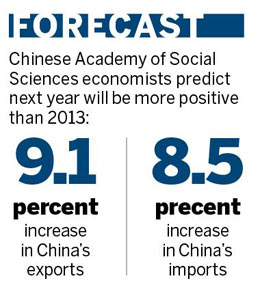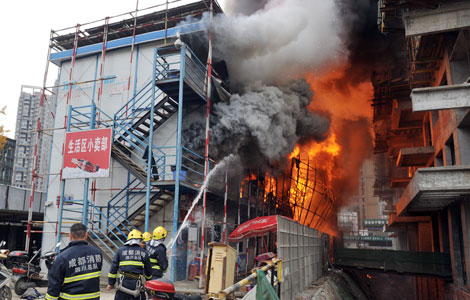
China opened its annual Central Economic Work Conference on Tuesday amid economists' calls for stronger and more concrete efforts for reform.
The meeting is set to review China's economic progress in 2013 and map out plans for 2014, an important year for carrying out a reform blueprint adopted last month, economists said.

The conference is expected to lead to a series of strategic planning meetings at the turn of the year, including for urbanization and rural development.
"Maintaining steady economic progress will be the top priority," said Li Ping, director of the Institute of Quantitative and Technical Economics under the Chinese Academy of Social Sciences.
"Under that condition, restructuring reforms can be pushed forward to cope with a new stage of growth," Li said.
Li Yang, deputy head of the academy, a major government think tank, said China cannot wait any longer to transform its pattern of growth, and economic policies should focus on quality growth and efficiency instead of bailouts and high-speed growth in the short term.
Economists said China's economy has entered a new era of structural slowdown, and the rate of economic growth is likely to decrease to less than 6 percent by the end of 2030.
"The structural slowdown is not a concern by itself. But it requires an adjustment of the macroeconomic policy framework," Li Yang said.
The CASS economists aired their views at a forum to mark the publication of the Blue Book of China's Economy, a book of economic reviews and forecasts.
Despite uncertainties, the international environment next year is expected to be more positive than 2013, as the United States may continue to recover and the European Union is likely to be out of recession, which will boost China's exports by an estimated 9.1 percent and imports by 8.5 percent, the CASS said.
The think tank suggested the leadership should maintain proactive fiscal policy and prudent monetary policy next year. It highlighted controlling local government debt risk as well as keeping the money supply and credit growth at a "proper" speed.
Excessive production capacity in the industrial sector, growing costs for labor and capital, quickly increasing local government debt and environment pollution will be the main factors restraining the nation's economic development, said Li Xuesong, a researcher at the academy.
"Pressure for the banking industry is likely to rise in the future. If the economic growth rate sharply decreases in the short term, a crisis in non-performing loans in the banking system will break out in the next two or three years," Li Xuesong said.
In addition, the central government's growth in fiscal income may see an obvious slowdown, he added.
Chang Jian, a senior economist in China at Barclays Capital, said the government may consider lowering the growth target in 2014 to control the potential financial risks and leave more room for reforms.
"Since economic development points to slower growth, lowering the growth target to 7 percent would be more appropriate," she said. "That would also help to guide the expectations of local governments, though the initial response from global investors could be negative."
"So the government's commitment to rebalance the economy can be reflected in the GDP growth target for next year," Chang said.
chenjia1@chinadaily.com.cn








